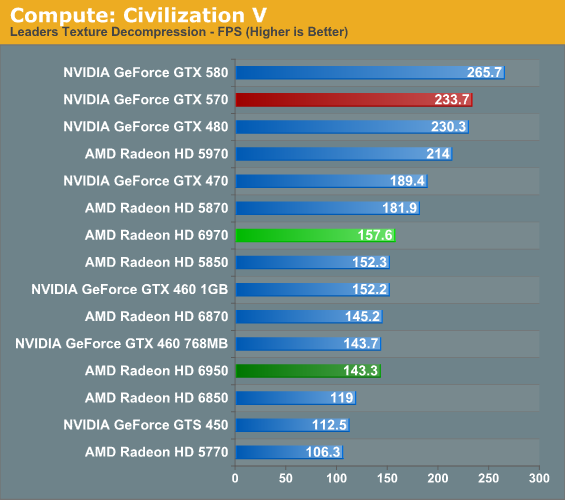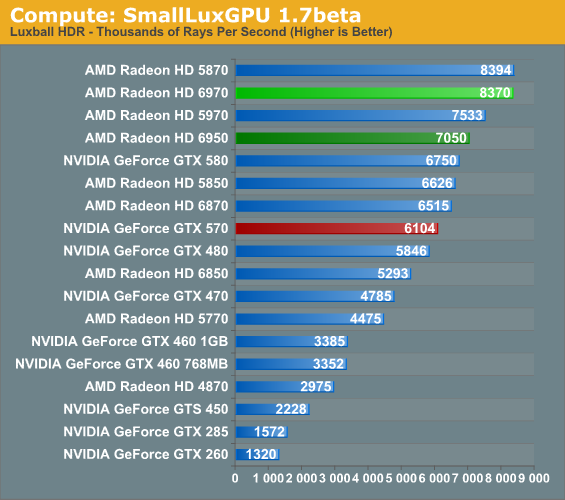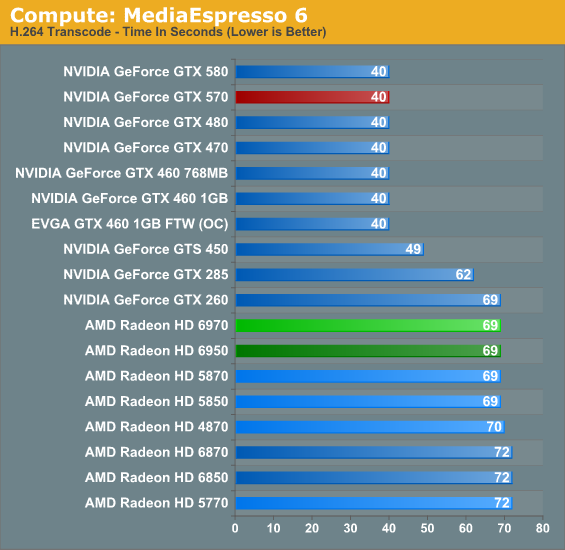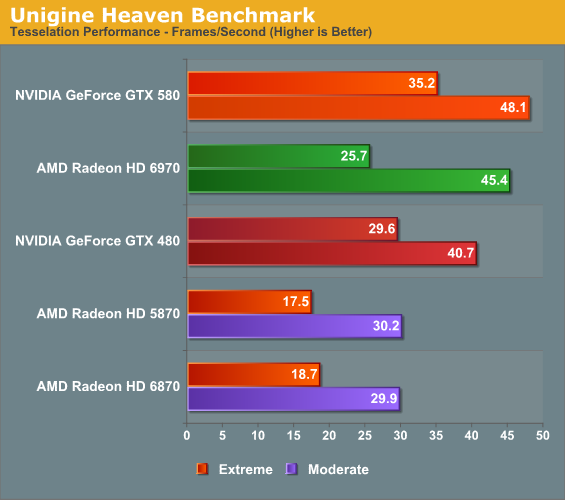AMD's Radeon HD 6970 & Radeon HD 6950: Paving The Future For AMD
by Ryan Smith on December 15, 2010 12:01 AM ESTCompute & Tessellation
Moving on from our look at gaming performance, we have our customary look at compute performance, bundled with a look at theoretical tessellation performance. This will give us our best chance to not only look at the theoretical aspects of AMD’s tessellation improvements, but to isolate shader performance to see whether AMD’s theoretical performance advantages and disadvantages from VLIW4 map out to real world scenarios.
Our first compute benchmark comes from Civilization V, which uses DirectCompute to decompress textures on the fly. Civ V includes a sub-benchmark that exclusively tests the speed of their texture decompression algorithm by repeatedly decompressing the textures required for one of the game’s leader scenes.

Civilization V’s compute shader benchmark has always benefitted NVIDIA, but that’s not the real story here. The real story is just how poorly the 6900 series does compared to the 5870. The 6970 barely does better than the 5850, meanwhile the 6950 is closest to NVIDIA’s GTX 460, the 768MB version. If what AMD says is true about the Cayman shader compiler needing some further optimization, then this is benchmark where that’s readily apparent. As an application of GPU computing, we’d expect the 6900 series to do at least somewhat better than the 5870, not notably worse.
Our second GPU compute benchmark is SmallLuxGPU, the GPU ray tracing branch of the open source LuxRender renderer. While it’s still in beta, SmallLuxGPU recently hit a milestone by implementing a complete ray tracing engine in OpenCL, allowing them to fully offload the process to the GPU. It’s this ray tracing engine we’re testing.

Unlike Civ 5, SmallLuxGPU’s performance is much closer to where things should be theoretically. Even with all of AMD’s shader changes both the 5870 and 6970 have a theoretical 2.7 TFLOPs of compute performance, and SmallLuxGPU backs up that number. The 5870 and 6970 are virtually tied, exactly where we’d expect our performance to be if everything is running under reasonably optimal conditions. Note that this means that the 6950 and 6970 both outperform the GTX 580 here, as SmallLuxGPU does a good job setting AMD’s drivers up to extract ILP out of the OpenCL kernel it uses.
Our final compute benchmark is Cyberlink’s MediaEspresso 6, the latest version of their GPU-accelerated video encoding suite. MediaEspresso 6 doesn’t currently utilize a common API, and instead has codepaths for both AMD’s APP and NVIDIA’s CUDA APIs, which gives us a chance to test each API with a common program bridging them. As we’ll see this doesn’t necessarily mean that MediaEspresso behaves similarly on both AMD and NVIDIA GPUs, but for MediaEspresso users it is what it is.

MediaEspresso 6 quickly gets CPU bottlenecked when paired with a faster GPU, leading to our clusters of results. For the 6900 series this mostly serves as a sanity check, proving that transcoding performance has not slipped even with AMD’s new architecture.
At the other end of the spectrum from GPU computing performance is GPU tessellation performance, used exclusively for graphical purposes. For the Radeon 6900 series, AMD significantly enhanced their tessellation by doubling up on tessellation units and the graphic engines they reside in, which can result in up to 3x the tessellation performance over the 5870. In order to analyze the performance of AMD’s enhanced tessellator, we’re using the Unigine Heaven benchmark and Microsoft’s DirectX 11 Detail Tessellation sample program to measure the tessellation performance of a few of our cards.

Since Heaven is a synthetic benchmark at the moment (the DX11 engine isn’t currently used in any games) we’re less concerned with performance relative to NVIDIA’s cards and more concerned with performance relative to the 5870. So with AMD’s tessellation improvements we see the 6970 shoot to life on this benchmark, coming in at nearly 50% faster than the 5870 at both moderate and extreme tessellation settings. This is actually on the low end of AMD’s theoretical tessellation performance improvements, but then even the geometrically overpowered GTX 580 doesn’t get such clear gains. But on that note while the 6970 does well at moderate tessellation levels, at extreme tessellation levels it still falls to the more potent GTX 400/500 series.

As for Microsoft’s DirectX 11 Detail Tessellation Sample program, a different story is going on. The 6970 once again shows significant gains over the 5870, but this time not against the 6870. With the 6870 implementing AMD’s tessellation factor optimized tessellator, most of the 6970’s improvements are already accounted for here. At the same time we can still easily see just how much of an advantage NVIDIA’s GTX 400/500 series still has in the theoretical tessellation department.










168 Comments
View All Comments
cyrusfox - Wednesday, December 15, 2010 - link
You should totally be able to do a 4X1 display, 2 DP and 2 DVI, as long as one of those DP dells also has a DVI input. That would get rid of the need for your usb-vga adapter.gimmeagdlaugh - Wednesday, December 15, 2010 - link
Not sure why AMD 6970 has green bar,while NV 580 has red bar...?
medi01 - Wednesday, December 15, 2010 - link
Also wondering. Did nVidia marketing guys called again?Ryan Smith - Wednesday, December 15, 2010 - link
I normally use green for new products. That's all there is to it.JimmiG - Wednesday, December 15, 2010 - link
Still don't like the idea of Powertune. Games with a high power load are the ones that fully utilize many parts of the GPU at the same time, while less power hungry games only utilize parts of it. So technically, the specifications are *wrong* as printed in the table on page one.The 6970 does *not* have 1536 stream processors at 880 MHz. Sure, it may have 1536 stream processors, and it may run at up to 880 MHz.. But not at the same time!
So if you fully utilize all 1536 processors, maybe it's a 700 MHz GPU.. or to put it another way, if you want the GPU to run at 880 MHz, you may only utilize, say 1200 stream processors.
cyrusfox - Wednesday, December 15, 2010 - link
I think Anand did a pretty good job of explaining at how it reasonably power throttles the card. Also as 3rd party board vendors will probably make work-arounds for people who abhor getting anything but the best performance(even at the cost of efficiency). I really don't think this is much of an issue, but a good development that is probably being driven by Fusion for Ontario, Zacate, and llano. Also only Metro 2033 triggered any reduction(850Mhz from 880Mhz). So your statement of a crippled GPU only holds for Furmark, nothing got handicapped to 700Mhz. Games are trying to efficiently use all the GPU has to offer, so I don't believe we will see many games at all trigger the use of powertune throttling.JimmiG - Wednesday, December 15, 2010 - link
Perhaps, but there's no telling what kind of load future DX11 games, combined with faster CPUs will put on the GPU. Programs like Furmark don't do anything unusual, they don't increase GPU clocks or voltages or anything like that - they just tell the GPU - "Draw this on the screen as fast as you can".It's the same dilemma overclockers face - Do I keep this higher overclock that causes the system to crash with stress tests but works fine with games and benchmarks? Or do I back down a few steps to guarantee 100% stability. IMO, no overclock is valid unless the system can last through the most rigorous stress tests without crashes, errors or thermal protection kicking in.
Also, having a card that throttles with games available today tells me that it's running way to close to the thermal limit. Overclocking in this case would have to be defined as simply disabling the protection to make the GPU always work at the advertised speed.
It's a lazy solution, what they should have done is go back to the drawing board until the GPU hits the desired performance target while staying within the thermal envelope. Prescott showed that you can't just keep adding stuff without any considerations for thermals or power usage.
AnnihilatorX - Wednesday, December 15, 2010 - link
Didn't you see you can increase the throttle threshold by 20% in Catalyst Control Centre. This means 300W until it throttles, which in a sense disables the PowerTune.Mr Perfect - Thursday, December 16, 2010 - link
On page eight Ryan mentions that Metro 2033 DID get throttled to 700MHz. The 850MHz number was reached by averaging the amount of time Metro was at 880MHz with the time it ran at 700MHz.Which is a prime example of why I hate averages in reviews. If you have a significantly better "best case", you can get away with a particularly bad "worst case" and end up smelling like roses.
fausto412 - Wednesday, December 15, 2010 - link
CPU's have been doing this for a while...and you are allowed to turn the feature off. AMD is giving you a range to go over.It will cut down on RMA's, Extend Reliability.